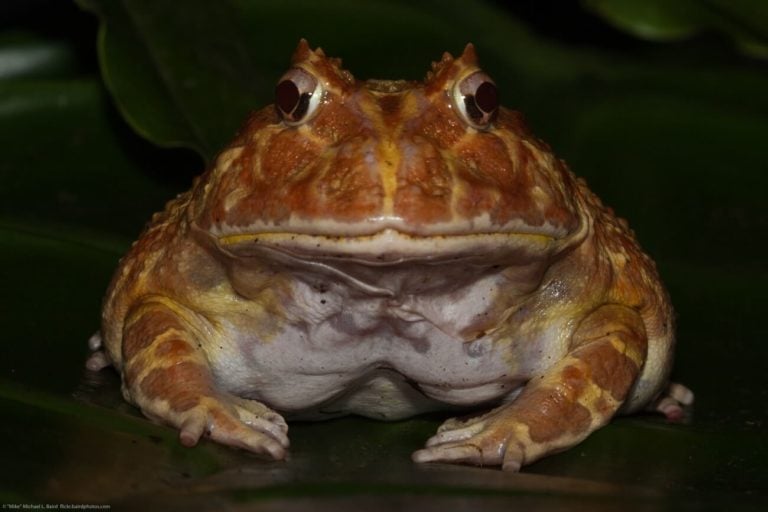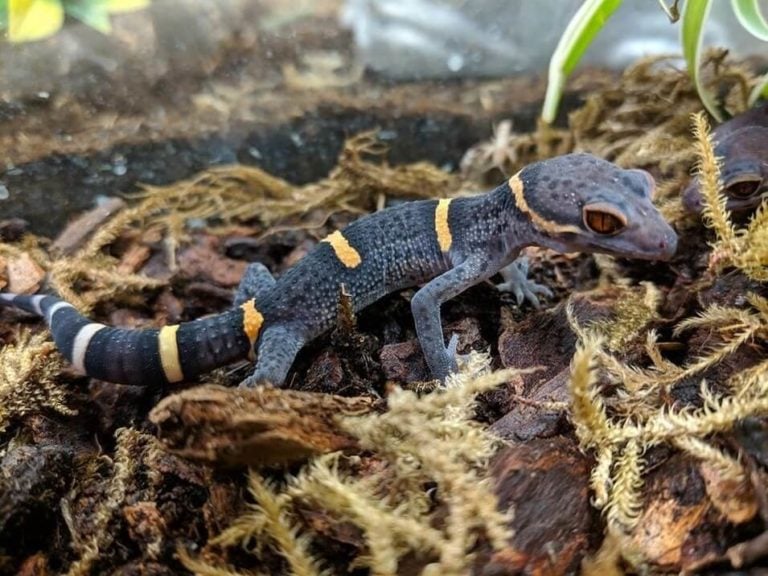Pygmy chameleons are an adorable pet reptile that you have to see to believe. These tiny creatures are as cute as it gets!
Because of this, there’s a lot of interest in owning these reptiles. And while they are generally rather low-maintenance, there are some things you’ll need to know before you purchase one.
This comprehensive guide will teach you the fundamentals of pygmy chameleon care. Everything you need to know is covered!
Table of Contents
Species Summary
Pygmy chameleons are known by reptile devotees to be an easy-going and sweet pet. However, this particular type of chameleon is better suited to intermediate reptile owners.
There are several variations of pygmy chameleons, and they each have their own physical characteristics. What unifies them is their natural habitat of the forests and woodlands of East Africa.
Expert Tip: Most pygmy chameleons are wild-caught, so be very careful before buying one. Make sure it looks healthy and well adjusted before bringing it home.
Appearance & Colors
Pygmy chameleons may not be as colorful as some other species of chameleons, but they still possess their own unique charm.
As mentioned above, there are several varieties of pygmy chameleons, and each one has its own special coloration and pattern. Because the natural habitat of these chameleons is the forest floor, their coloration helps them to blend in perfectly with their natural surroundings.
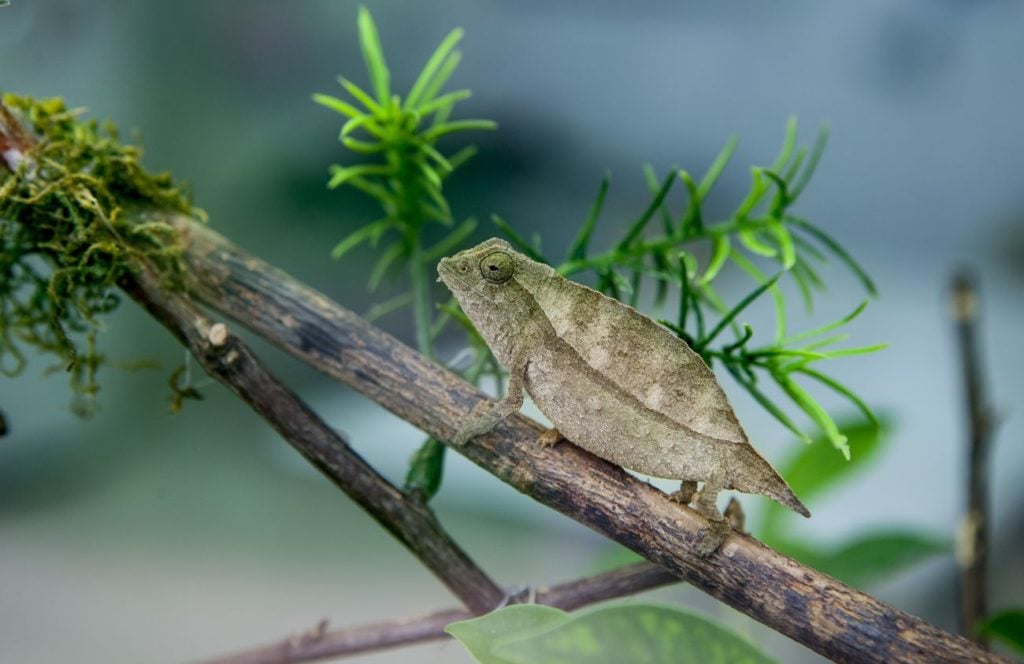
The basic body color of the pygmy chameleon ranges from a light brown to gray. Depending on the type of pygmy chameleon, you’ll see stripes in brown, green or even a light red. These colors will often become more vivid during courtship.
There is also a wide variation of body structure among the different varieties of pygmy chameleons. Some have a beard-like protrusion, some have what looks like a horn on the nose and others have lips like a duck.
The one common feature among the different types is the tail. Since pygmy chameleons stay on the forest floor, they don’t need the long, curly tail found on other chameleons. Instead, they have short, truncated tails.
Pygmy Chameleon Lifespan
The typical lifespan of a pygmy chameleon is between one and three years, even with great care and an optimal habitat. These little reptiles are not known for their longevity.
While pygmy chameleons aren’t pets you’ll have for a long time, there are still a number of things about them that will allow you to build a strong bond (more on that later).
Average Size
As you may have guessed from their name, these reptiles are very small. The average pygmy chameleon size at adulthood is only three to three and a half inches long. This measurement includes the tail.
What they lack in size, they more than make up for in cuteness and temperament. There’s something fascinating about owning such a small pet!
Pygmy Chameleon Care
Pygmy chameleon care is not very challenging, since these animals are generally low-maintenance. However, you will still need to have some level of intermediate knowledge of reptile husbandry.
A proper setup with appropriate enclosure enhancements, a knowledge of diet and feeding schedules and a basic understanding of potential health issues are the keys to giving your pygmy chameleon the best care.
Enclosure Size
Because pygmy chameleons don’t need large setups, they are the perfect match for pet owners that don’t have lots of extra space. We suggest using a five gallon glass tank for one chameleon.
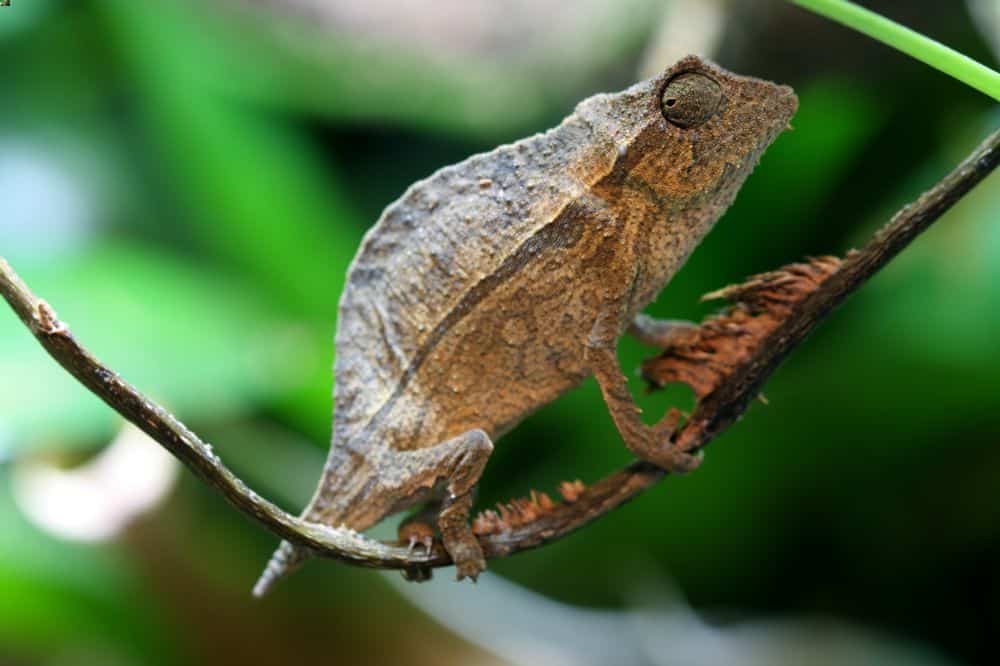
If you plan on housing more than one in an enclosure, add five gallons per chameleon.
Pygmy chameleons are not climbers, so keeping them in an enclosure with plenty of horizontal space is great. This is especially important for multi-chameleon enclosures because each chameleon likes to establish its own area.
We don’t suggest housing males together, although it can be done in a very large tank. Males and females can be housed together successfully.
Expert Tip: Make sure that your enclosure has a sturdy lid. Your chameleon may try to climb out of the tank, and a lid will help to protect them from cats, kids and other dangers.
Habitat Setup
Putting together the habitat setup for your pygmy chameleon can be a lot of fun. Since these friendly lizards are forest floor dwellers, they will be the most comfortable in an enclosure that resembles their natural environment.
Plants, whether real or fake, should make up the majority of your chameleon’s environment. This is going to give your pet the ability to hide and feel safe.
Both natural and fake plants will need to be washed before they are placed in the tank. Pygmy chameleons have been known to give plants a nibble, and pesticides or toxins on the plants can be deadly.
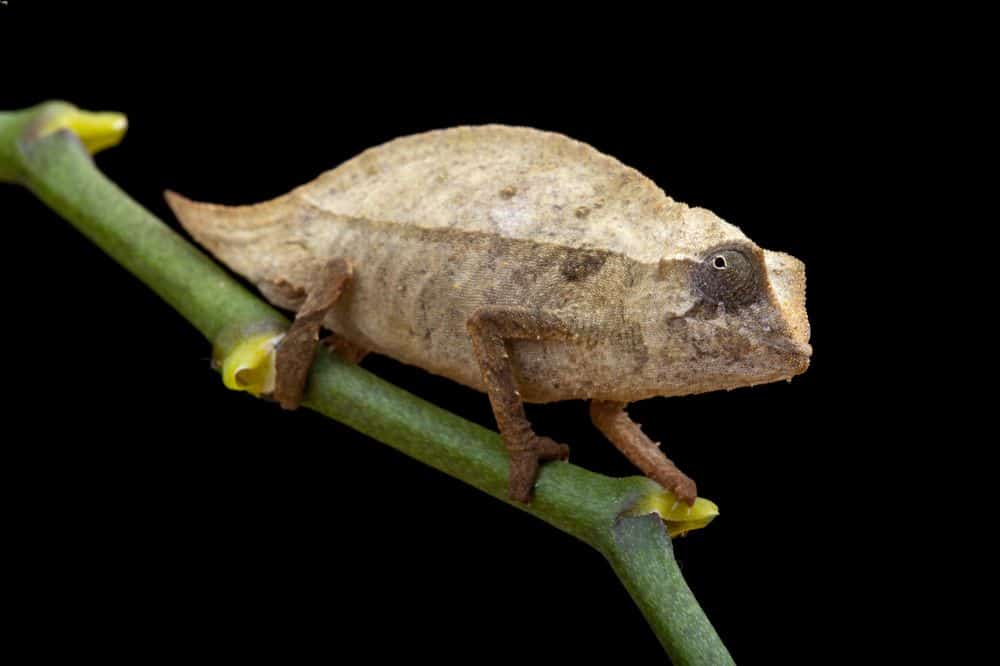
If you choose to go the natural plant route, some suggested chameleon-safe plants include golden pothos, croton, hibiscus and Madagascar dragon tree.
As for the substrate, we recommend a two to four inch bedding of coconut bedding. Put a layer of gravel under the bedding if you are going to use real plants (this provides necessary drainage).
It’s good to add some small sticks to the enclosure as well. Your pygmy chameleon will enjoy climbing them.
Temperature & Lighting
Pygmy chameleons don’t require anything fancy when it comes to both temperature and lighting.
Unlike most pet reptiles, they don’t really need a temperature gradient or supplemental UVB lighting. This could be because in the wild, pygmy chameleons live on the forest floor and don’t need as much UVB as arboreal chameleons.
They like a temperature between 65 and 80 degrees Fahrenheit. The ideal sweet spot is usually around 70°F (aka room temperature).
Expert Tip: It’s very important to never let the temperature of the enclosure go above 80 degrees Fahrenheit.
Basking lights or under-the-tank heaters are totally unnecessary. If you want, you can add a UVB bulb to your setup, but pygmy chameleons don’t really need this type of lighting. They do, however, need a light cycle of 12 hours on and 12 hours off.
Humidity
Keeping a consistent level of humidity in the enclosure is very important. These little reptiles need a humidity level that always stays between 60 and 80 percent.
There are a couple ways that you can create the humid environment your pygmy chameleon needs, with the first being misting.
Misting the enclosure twice a day is the best way to keep the humidity at the right level. We suggest misting in the morning and again about an hour before you turn off the lights at night.
When misting, remember that you want to keep the environment moist, not wet. Over-misting is not recommended. Some people choose to use an automatic mister, but trigger hand sprayers are actually the best.
Including live plants in their habitat (which we discussed earlier) is another great way to maintain humidity levels. They add some natural beauty as well!
Water
Pygmy chameleons don’t require anything special as far as water goes. They can get all the water they need by drinking water droplets that form after you mist the enclosure.
Watch closely, and you’ll see them drinking the droplets from the plants and leaf litter! It’s just as cute as it sounds.
Expert Tip: Since your chameleon uses the mist droplets for its water source, it’s very important to mist the enclosure with non-chlorinated water.
Food & Diet
Pygmy chameleons are pretty easy to feed, and following a few simple guidelines is really all you need to do to keep your chameleon happy and healthy.
- The first rule of thumb is that the food you give to your pygmy chameleon should never be longer than the width of the chameleon’s head.
- Your pygmy chameleon is an insectivore and should be given live insects such as small crickets, fruit flies or baby silkworms. Pygmy chameleons love house flies, so treat them to a house fly snack once in a while. All food (except maybe house flies) should be gut loaded with nutritious items like carrots or broccoli.
- Dust insects with a powdered calcium and vitamin supplement before feeding time.
- It’s a good idea to feed your pygmy chameleon in the morning. This gives it plenty of time for proper digestion.
- Give neonates plenty of pinhead crickets and fruit flies. They will need to be fed daily. Older pygmy chameleons, three to six months old, can have six to ten crickets every day. Your adult chameleon can be fed 4-6 small crickets every other day.
Possible Health Concerns
Pygmy chameleons, like all pets, can become sick. That’s why it is so important to develop a good relationship with a veterinarian that has experience with reptiles.
Once you take on the responsibility of pet ownership, you will need to make sure that you keep an eye out for any potential health issues. Let’s take a quick look at some health issues that are common to pygmy chameleons.
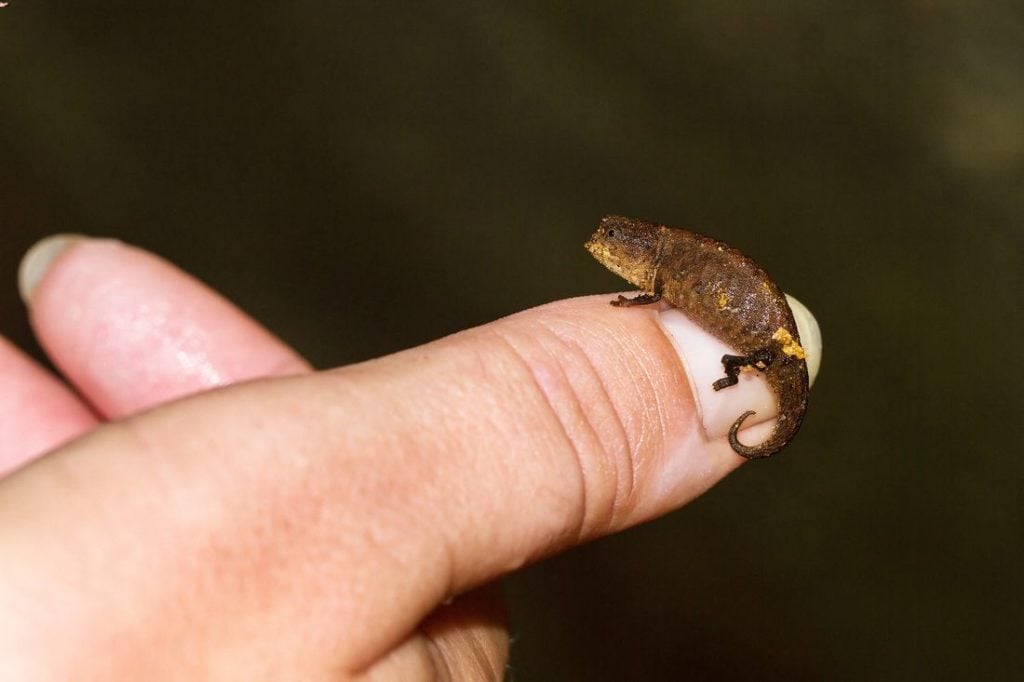
Pygmy chameleons can develop painful mouth sores that will need to be treated by a vet. Most of these sores are caused by bacterial infections, so your chameleon would need antibiotics to clear up the infection.
Sometimes your pygmy chameleon will be bitten by prey or will scratch itself on a branch or other enclosure enhancement. These scratches can become infected quickly, so take your chameleon to a vet for treatment.
Metabolic bone disease is another health issue that is common with pet reptiles. This can be easily prevented with proper diet supplementation.
If you notice that your chameleon is lethargic, stops eating or drinking, is gasping for breath or is staying a darker color, take your pet to the vet right away. Pygmy chameleons can get very sick, very quickly, so it’s wise to take a visual health assessment of your chameleon on a daily basis.
Behavior & Temperament
One thing you’ll notice about your pygmy chameleon is its nice, friendly temperament. It’s this easy-going disposition that makes it popular with reptile owners. Still, it’s best to not handle your pygmy chameleon too much (more on that in the section below).
Some pygmy chameleon owners claim that it’s possible to house more than one male together, but we don’t recommend it. Even in a large enclosure with plenty of space, they can get stressed, and you may notice them emitting a type of buzzing sound if they feel threatened.
Expert Tip: Putting males together with females or having multiple females in the same enclosure is fine. Always make sure that there is enough room for each chameleon to stake out its own little section of the tank. Having its own territory will make each chameleon feel secure.
Although pygmy chameleons will climb and explore branches in the enclosure, they are not really known to be climbers. Instead, they prefer to hang out on the bottom of the tank.
Handling Them
Pygmy chameleons are prized for their friendly attitude towards their owners. However, this does not mean that they enjoy being over-handled.
The best thing is to just let them live as peacefully as possible in the natural and comfortable environment that you created for them.
It is a good idea to give them a close physical inspection every couple of weeks or so. When you do this, pick them up gently, and be very careful not to drop them. This should really be the only time that you’ll need to handle them.
Your pygmy chameleon is happiest when it is left to bask, hide and climb in peace!
Conclusion
Pygmy chameleons are an amazing pet reptile that we recommend all the time. Caring for them is simple, and their small size makes them very fun to spectate.
We hope this care sheet has helped you feel more prepared for owning one yourself. While there’s always uncertainty when getting a new pet, we believe that you’ll do a great job (as long as you follow our recommendations).
Have fun!

